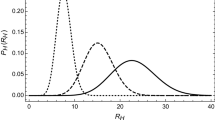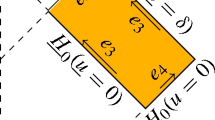Abstract
A simple, geometrical construction is given for three-dimensional spacetimes with negative cosmological constant that contain two particles colliding head-on. Depending on parameters like particle masses and distance, the combined geometry will be that of a particle, or of a black hole. In the black hole case the horizon is calculated. It is found that the horizon typically starts at a point and spreads into a closed curve with corners, which propagate along spacelike caustics and disappear as the horizon passes the particles.
Similar content being viewed by others
References
The analogous construction using a space-like geodesic and Lorentz boost is sometimes referred to as a tachyon, but it is equally appropriate to interpret it as the singularity inside a black hole, at least in spacetimes where such black holes exist
Here the radial coordinate q is defined to that the circumference of a circle q = const. is 2πq. These coordinates are related to another common form of the AdS metric, ds 2 = − cosh2 r dt 2 + dr 2 + sinh2 r dΩ2 by the substitution q = sinh r
See S Holst, Gen. Relativ. Gravit. 28, 387 (1996), where these coordinates are called ‘Poincaré coordinates’
Sören Holst, Horizons and time machines, Thesis in Theoretical Physics, Chapter 4, Department of Physics, Stockholm, 2000, ISBN 91-7265-054-0
Bañados, Teitelboim and Zanelli, Phys. Rev. Lett. 69, 1849 (1992) Bañados, Henneaux, Teitelboim and Zanelli, Phys. Rev. D48, 1506 (1993)
If one or both masses are replaced by black holes, a similar formula holds with trigonometric functions replaced by hyperbolic ones.
H-J Matschull, Class. Quant. Grav. 16, 1069 (1999)
D Brill, Phys. Rev. D53, R4133 (1996) A Steif, Phys. Rev. D53, 5527 (1996)
S DeDeo and R Gott, Phys. Rev. D66, 084820 (2002)
S Holst and H-J Matschull, Class. Quant. Grav. 16, 3095 (1999)
Author information
Authors and Affiliations
Rights and permissions
About this article
Cite this article
Brill, D., Khetarpal, P. & Kaul, V. Horizons in 2+1-dimensional collapse of particles. Pramana - J Phys 69, 109–118 (2007). https://doi.org/10.1007/s12043-007-0113-6
Published:
Issue Date:
DOI: https://doi.org/10.1007/s12043-007-0113-6




